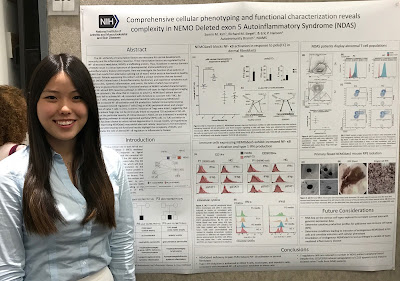Somin Kim is a rising senior majoring in Biology. She was awarded a Spring 2018 Independent Grant which she used to conduct research on myopia under Dr. John Nickerson.
It was in seventh grade when I first wanted to become an ophthalmologist. My mother’s vision had been deteriorating to the point of legal blindness, and it was around this time that my mother’s optometrist confirmed that this deterioration would continue until she was completely blind. It was the classic, “Someone dear to me is suffering; I will become the solution so she and others like her don’t have to” that drives so many into the field of medicine. But it wasn’t until I joined my lab at the Emory Eye Center that I became truly enamored by the eye. My drive towards an MD/PhD was no longer a one-dimensional desire; it was now rooted by my complete fascination on the organ that lets us perceive reality.
The first thing people wonder when I tell them I do ocular research it what can be so interesting about eyes (that, or they ask me how I can work with something so creepy). Cataract surgery is the most common surgical procedure done in the US and by 2050 it is projected that 50% of the world will be myopic—although you may not realize it, deterioration of the eye is something that effects everyone with age. With a condition this prevalent, the field is always changing, drawing me towards its consistently new and engaging research.
My project specifically aims to possibly find a new method to combat retinal degeneration (RD) and myopia. I am using the histone deacetylate inhibitor (HDACi) Trichostatin-A in a myopic and retinal degeneration mouse model, the interphotoreceptor retinoid-binding protein deficient (IRBP KO) mouse model. Epigenetics has recently emerged as an important field to investigate when attempting to understand disease. It is defined as the alteration in gene expression due to changes in the environment, independent of changes in genome sequence. My project is novel in the fact that the role of histones in the development of myopia and RD has not been explored. Based on studies done in other models, I hypothesized that the addition of an HDAC inhibitor to our IRBP KO mouse model will slow the development of myopia and prevent severe retinal layer loss.
What was challenging for me at first in this research is that all my experiments are animal based. In previous labs I primarily worked with cell culture—I had my cells ready to go at any time when I wanted to conduct an experiment. My current HDACi injection period in my mice is P40-P45. That means I have to wait until my mice are 40 days old before I can start my injection rounds. That also means that if I miss my targeted day, I either have to alter my experiment or I have to wait until my next batch of mice are of age. I had to learn how to deal with animal variation in my results. I also had to learn many vision science specific techniques such as how to perform electroretinograms (these test retinal function) or how to do a variety of in vivo imaging techniques like SD-OCT or Bioptigen (allows one to take detailed images of the back of the eye and retinal layers). Overall, I was surprised at how we could do so many techniques on something as tiny as a mouse’s eye.
My research experience at Emory has been, no pun intended, eye-opening. It has taught me the ins and outs of mouse work and basic vision science and has truly pushed me towards becoming an independent scientist. I now have the experience of independently designing a project, writing grants to support my project, and starting that project. What’s left now is to finish this project up so I can start on the next one!
Visit the Undergraduate Research Programs website to learn more about applying for Independent Research Grants.


Comments
Post a Comment